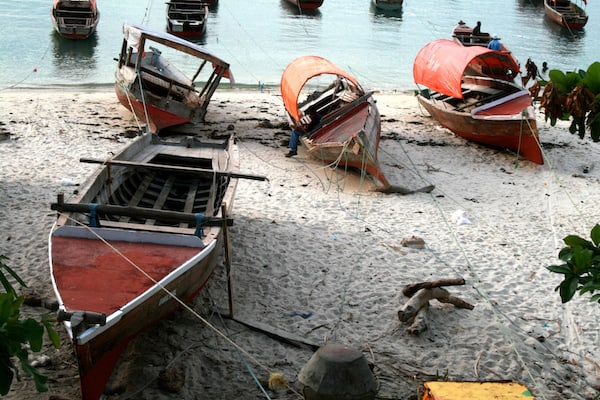Book Review of Robert D. Kaplan’s “Monsoon. The Indian Ocean and the Future of American Power“
Monsoon provides a very detailed analysis of the ongoing transition of power relations and the “disappearance of the former third world” (p. 295). The historical perspective taken in this publication shows (geo-)political enmeshments as well as the dynamics of the rise and fall of empires in the history of the Indian Ocean and the world as a whole. Every chapter explores the connection between the shrinking power of the USA and the move towards an upcoming multilateral world power. Robert Kaplan focuses on the main stages of the transition by providing the reader with historical background information as well as ongoing trends, explaining his vision of the future in which the world meets in the Indian Ocean. The transitions will not only be followed by changing ways of governance, he argues, but also by a new picture of Islam that will lose its connotation of the “enemy”. Indonesia, as the state with the largest Muslim population, will become more and more important in this global political scenario.
According to Kaplan, the Indian Ocean will turn into the heart of a new geopolitical map. The author envisions a shift from a unilateral world power to multilateral power cooperation; the strategic center will move from the West to the East. This transition is caused not only by the changing economic, but also military conditions of the USA, China and India which Kaplan sees as the upcoming powerful leaders of this new world order.
The book is composed of 17 chapters; each focuses on a certain historical step of the transition and on stopovers during the journey towards an interconnected Indian Ocean. His journalistic background leads to a writing style that invites the reader to follow his detailed descriptions. It is this aspect, combined with the circumstantial historical contextualization, which demonstrates that the book is not only written for an expert audience.
The book’s title Monsoon is a metaphor for a changing of world power. The monsoon as a rhythmic wind and weather system is defined by a changing of direction from the east to the west and from the west to the east. And in the same way the rhythm of global power changes.
One central feature of the new world order, Kaplan explains, is that the emerging powers will not be direct antagonists or enemies. Rather they are better described as rivals who will at some points compete and at others cooperate. This aspect is well explained in the first chapter of the book. Already the headline “China Expands Vertically, India Horizontally” shows the differing directions taken by the two, perhaps most important, rivals of the USA. This movement will predominantly take place on the sea because of the overlapping commercial and political leverages of China and India (p. 13). The sea has been important since antiquity because of trade, but there was a time of artificial separation during the Cold War and with its end the transition began. Maintaining access to the sea will become more and more crucial in order to build alliances with rivals and to prevent trading obstacles (p. 16). To balance China’s expanding economic and military power, India would have to cooperate with counties such as the USA, Japan and Singapore.
The starting point for Kaplan’s historical review of the steps of transition towards a new era of global power is the predominance of Omani merchants in the Indian Ocean. They used the knowledge of the rhythms of the monsoon to expand their trading relations towards the east. These merchants were the ones who brought Islam to South and Southeast Asia. Islam coexisted with other religions of the region like Buddhism and Hinduism and pilgrimages were also used to expand trading relations (p. 28). The situation for the Omani merchants changed dramatically with the arrival of the Europeans: especially the enforced abolition of the slave trade by the British Royal Navy, which had a deep impact on them because this was the main branch of trade for the Omani (p. 38).
However, the author describes that the Indian Ocean reached its modern era with the arrival of the Portuguese in the 15th century, which was mainly precipitated by the rediscovery of the wind system (p. 49), and it was at this point in history that the Indian Ocean changed rapidly. Since the Portuguese were Christian, they regarded Islam as an enemy and took action against Ottoman Turkey, Safavid Iran, Mughal India, and non-Muslim Ming China (p. 51). These actions were marked by hostility and brutality. While the Portuguese could not retain their predominance in the region against the Dutch and British, “they gave it [the Indian Ocean] a literary and historical unity, at least in the mind of the West” (p. 60).
But colonialism also did not stand the test of time. As mentioned above, with the end of the Cold War, India and China grew economically and increased their influence in the Indian Ocean region. Kaplan explains in numerous examples how China especially, as a country that is not geographically but geopolitically connected to the Indian Ocean, became such an important global player of the 21st century. A central aspect of this transition is its foreign policy, which is in contrast to that of the USA:
“[…] Chinese military aid does not come with lectures about human rights the way the West’s does. China does not interfere in another state’s internal politics and does not tolerate interference in its own. Chinese foreign policy, without being in any way extreme or bellicose, nevertheless represents the bleakest form of realism. It indicates a new bipolarity in the world: between those states that employ human rights as part of their policy calculations and those that do not” (p. 208).
As its influence is growing and expanding, China has to be careful not to provoke India too much by getting increasingly involved in the Indian Ocean region. As the author emphasizes, India as the upcoming third largest sea power, is strongly concerned with its troubling neighboring countries. Since China invaded Tibet, India became more concerned with Chinese political strategy, which led to a deeper cooperation with the US Navy. “China was the elephant in the room that drove India and the US closer together” as Kaplan puts it metaphorically (p. 129). Keeping this aspect in mind, projects like the deepwater ports at Pakistani Gwadar (Chapter 5) and the seaport at Sri Lankan Hambantota (Chapter 11) financed and built by China became sensitive topics. The most serious Chinese involvement is taking place in Myanmar (Burma), which the author describes as the place where both superpowers collide in accordance to their moves of direction and interests (see also Where China Meets India by Thant Myint-U, 2011). China desires Myanmar as a “vassal state” (p. 217), which should guarantee access to the Indian Ocean and provide a route for pipelines through its state territory for China. On the other side, India fears and has already faced insurgencies at its borders because of internal tensions and outbreaks of violence in Myanmar.
Another important stage where China, India and the USA have to compete and cooperate at the same time is Indonesia (Chapter 13, 14). The Strait of Malacca is the most important sea strait of the Indian Ocean for trading vessels since many different interests meet and the main goal is to keep access to this area. But the situation can change rapidly: an increased weakening of Malaysia as well as Singapore might result in a greater dependency on China; the returning of piracy or the rise of Islamic extremists (or Buddhist, one might add in light of recent events in Myanmar and Sri Lanka), are other scenarios that could lead to a rift. Finally, environmental catastrophes such as the 2004 Tsunami could influence the transition.
Turning to the African Indian Ocean coast, Kaplan’s last destination is Zanzibar, which he describes as the last frontier of the Indian Ocean. It is a frontier that – in the words of Kaplan – has to get over its post-colonial past. This implies the need for building up strong institutions that do not discriminate its inhabitants due to “race, ethnicity and other factors of identity” (p. 315). Trade appears as the most important guarantor of such a vision, as “equalizer among people and nations” (p. 317). It is already increasing in Zanzibar, which goes along with a growing middle class that is the key of the transition of the Indian Ocean:
“[…] The challenges that most people in the Indian Ocean region face are only indirectly, if at all, related to Islamic terrorism and the military rise of China. Precisely because so many of the challenges – and hopes and dreams – of this new middle class are personal and materialistic, there will be increasing calls for better government and, yes, democracy” (p. 321).
In summary, Robert D. Kaplan focuses on the benefits of the transition to a multilateral global power with its center in the Indian Ocean. But he also mentions the shady sides of the changes: the rise of nationalism in accordance with the fear of a new hegemon as well as internal conflicts that will affect the trading system. Moreover, challenges in dealing with natural disasters, terrorism, and piracy are mentioned. But Kaplan highlights from time to time that such challenges will lead to a deeper cooperation between the nations of the globe. Global powers will have to act differently than before, because they are under increasing scrutiny by a global community (p. 323).
Besides this well prepared analysis, Kaplan works with politically sensitive categories like “third world country” (p. 144, 142, 156, 184 etc.), “hill tribes” (p. 220 etc.) and “failed state” (p. 298) which have a western-centric component. While the author in many cases describes the diversity within a country, at some points he speaks in the name of the whole nation even though it would be better to point out nuances to prevent giving the wrong impression, especially for readers who are not familiar with the history and politics of the region. However, the book remains important especially in giving an insight into a transiting world. Apart from Kaplan’s analysis of the current transition of power, the book could also be read as a plea towards the US Government to change their western-centric point of view and to look more towards the East without fearing the decline of its own power.
Literature cited:
Thant Myint-U. 2011. Where China Meets India. Burma and the new Crossroads of Asia. London: Faber and Faber.
Robert D. Kaplan’s “Monsoon. The Indian Ocean and the Future of American Power.“ Random House Trade Paperbacks; Reprint edition (September 13, 2011). 400 pages. ISBN 0812979206 2010.





